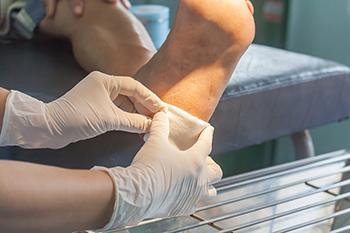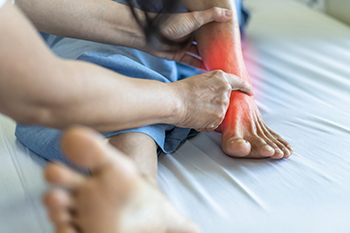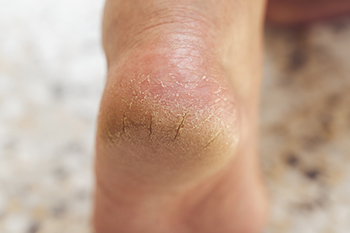
Wilmington (937) 382-2347
(513) 791-4764
Fax
(513) 932-1606

Wilmington (937) 382-2347
(513) 791-4764
Fax
(513) 932-1606

Foot wounds can arise from various causes, with diabetic foot ulcers being a significant concern. Diabetes can lead to poor circulation and nerve damage, reducing the ability to feel injuries and heal properly. Other causes include trauma, such as cuts, burns, or punctures, and pressure sores from prolonged immobility. Proper management of foot wounds involves regular inspection, cleaning, and dressing changes to prevent infection. For diabetic foot ulcers, maintaining blood sugar levels and wearing appropriate footwear is essential. Applying antibiotic ointments and using offloading devices, such as special shoes or braces, can reduce pressure on the wound. Seeking medical attention from a podiatrist for persistent or severe wounds ensures appropriate treatment, which may include debridement or advanced therapies. If you have developed a foot wound, it is strongly suggested that you are under the care of a podiatrist who can effectively treat any foot condition, which include foot wounds.
Wound care is an important part in dealing with diabetes. If you have diabetes and a foot wound or would like more information about wound care for diabetics, consult with Dr. Gerald Perelman from Ohio. Our doctor will assess your condition and provide you with quality foot and ankle treatment.
What Is Wound Care?
Wound care is the practice of taking proper care of a wound. This can range from the smallest to the largest of wounds. While everyone can benefit from proper wound care, it is much more important for diabetics. Diabetics often suffer from poor blood circulation which causes wounds to heal much slower than they would in a non-diabetic.
What Is the Importance of Wound Care?
While it may not seem apparent with small ulcers on the foot, for diabetics, any size ulcer can become infected. Diabetics often also suffer from neuropathy, or nerve loss. This means they might not even feel when they have an ulcer on their foot. If the wound becomes severely infected, amputation may be necessary. Therefore, it is of the upmost importance to properly care for any and all foot wounds.
How to Care for Wounds
The best way to care for foot wounds is to prevent them. For diabetics, this means daily inspections of the feet for any signs of abnormalities or ulcers. It is also recommended to see a podiatrist several times a year for a foot inspection. If you do have an ulcer, run the wound under water to clear dirt from the wound; then apply antibiotic ointment to the wound and cover with a bandage. Bandages should be changed daily and keeping pressure off the wound is smart. It is advised to see a podiatrist, who can keep an eye on it.
If you have any questions, please feel free to contact our office located in Wilmington, OH . We offer the newest diagnostic and treatment technologies for all your foot care needs.

Inside ankle pain, or medial ankle pain, can result from several common causes. One frequent cause is posterior tibial tendonitis, where inflammation affects the tendon supporting the arch. Another potential cause is tarsal tunnel syndrome, a condition involving the compression of the tibial nerve. Medial ankle sprains, typically less common than lateral sprains, can also lead to significant pain and swelling. Preventing inside ankle pain involves strengthening the ankle muscles and tendons through exercises and stretches. Wearing properly fitted, supportive footwear can also help maintain proper alignment and reduce strain. Additionally, avoiding overuse and allowing adequate rest between activities can prevent tendonitis and other overuse injuries. If pain persists, it is suggested that you consult a podiatrist who can offer you effective treatment and prevention strategies.
Ankle pain can be caused by a number of problems and may be potentially serious. If you have ankle pain, consult with Dr. Gerald Perelman from Ohio. Our doctor will assess your condition and provide you with quality foot and ankle treatment.
Ankle pain is any condition that causes pain in the ankle. Due to the fact that the ankle consists of tendons, muscles, bones, and ligaments, ankle pain can come from a number of different conditions.
Causes
The most common causes of ankle pain include:
Symptoms
Symptoms of ankle injury vary based upon the condition. Pain may include general pain and discomfort, swelling, aching, redness, bruising, burning or stabbing sensations, and/or loss of sensation.
Diagnosis
Due to the wide variety of potential causes of ankle pain, podiatrists will utilize a number of different methods to properly diagnose ankle pain. This can include asking for personal and family medical histories and of any recent injuries. Further diagnosis may include sensation tests, a physical examination, and potentially x-rays or other imaging tests.
Treatment
Just as the range of causes varies widely, so do treatments. Some more common treatments are rest, ice packs, keeping pressure off the foot, orthotics and braces, medication for inflammation and pain, and surgery.
If you have any questions, please feel free to contact our office located in Wilmington, OH . We offer the newest diagnostic and treatment technologies for all your foot care needs.
 Cracked heels, medically known as keratoderma, is a condition where the skin on the heels becomes thick, dry, and eventually splits. This often painful issue arises from prolonged pressure on the feet, leading to hard, callused skin that can fissure. Causes include standing for long periods, wearing open-backed shoes, and exposure to dry, cold weather. Medical conditions like diabetes and hypothyroidism also contribute by causing excessively dry skin. Excessive weight increases pressure on the heel pads, further worsening the problem. Preventing keratoderma involves regular moisturizing, wearing supportive, closed-back footwear, and avoiding prolonged standing on hard surfaces. Proper foot care routines, including gentle exfoliation and hydration, are essential to maintain soft, healthy skin and prevent the discomfort associated with cracked heels. This condition can be painful. If this applies to you, it is suggested that you visit a podiatrist who can effectively treat cracked heels, which often includes prescribed medication.
Cracked heels, medically known as keratoderma, is a condition where the skin on the heels becomes thick, dry, and eventually splits. This often painful issue arises from prolonged pressure on the feet, leading to hard, callused skin that can fissure. Causes include standing for long periods, wearing open-backed shoes, and exposure to dry, cold weather. Medical conditions like diabetes and hypothyroidism also contribute by causing excessively dry skin. Excessive weight increases pressure on the heel pads, further worsening the problem. Preventing keratoderma involves regular moisturizing, wearing supportive, closed-back footwear, and avoiding prolonged standing on hard surfaces. Proper foot care routines, including gentle exfoliation and hydration, are essential to maintain soft, healthy skin and prevent the discomfort associated with cracked heels. This condition can be painful. If this applies to you, it is suggested that you visit a podiatrist who can effectively treat cracked heels, which often includes prescribed medication.
If the skin on your feet starts to crack, you may want to see a podiatrist to find treatment. If you have any concerns, contact Dr. Gerald Perelman from Ohio. Our doctor can provide the care you need to keep you pain-free and on your feet.
Cracked Heels
It is important to moisturize your cracked heels in order to prevent pain, bleeding, and infection. The reason cracked heels form is because the skin on the foot is too dry to support the immense pressure placed on them. When the foot expands, the dry skin on the foot begins to split.
Ways to Help Heal Them
Ways to Prevent Cracked Heels
If you are unsure how to proceed in treating cracked heels, seek guidance from a podiatrist. Your doctor will help you with any questions or information you may need.
If you have any questions, please feel free to contact our office located in Wilmington, OH . We offer the newest diagnostic and treatment technologies for all your foot care needs.